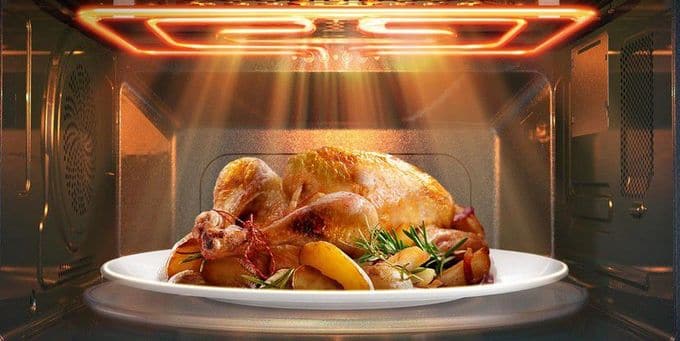Microwave for many decades is one of the most popular household kitchen appliances. The cooking method using microwave waves was patented by Percy Lebaron Spencer in 1945, and the first device was manufactured in 1947. The weight of this prototype exceeded 660 pounds. The discussion at the end of the 20th century on the safety of microwave radiation slowed down the spread of microwaves, but reliable door screening and numerous subsequent examinations eliminated the distrust of some consumers to this technique. Today, almost every modern kitchen has this device.
Price, technical values and functionality are the main criteria for choosing the optimal microwave. High demand is accompanied by active competition from manufacturers who are constantly improving their models by expanding their functionality with the help of innovative technologies. Today, most modern models even middle price segment support such modes as grill, convection and steaming. But, the grill mode is one of the most popular.
As known, the grill provides roasting. The grill operation in microwave is similar to the oven. Grill is heated up to 392-482 °F or 200-250 °C. High temperature provides formation of a crisp during cooking. Grill mode is designed on quite a long time and reaches 99 minutes. Grills of modern models primarily use heating elements of ceramic, quartz or electric type.
Tubular heater
Today tubular heaters are the most versatile of all electric heating elements. This is a metal tube with a heating element inside.
Usually, this element is located on the upper inner surface of the chamber.
Bottom location is less common. Virtually all modern models have adjustable grill position in the chamber. Such grill can move up, down, to the rear wall or is rotated 90 °, depending on the size and shape of cookware. Of course, adjustable grill is more functional. For example, some models allow the user to fry the chicken in a vertical position. Moreover, chamber with such grill is much easier cleared. This function is similar to adjusting the height of tray in the oven. Of course, the height affects on distance to the burner and, accordingly, the heat treatment intensity. Unfortunately, this option reduces the chamber capacity.
Quartz grill
Of course, increasing the useful internal space is one of the main advantages of a quartz heater.
As a rule, spiral is made in the form of tightly retinue wire of heat-resistant alloy of nickel and chromium that is soldered in a quartz tube. Such grill is fixedly on top above the working chamber and does not occupy a working space in chamber. Quartz grill is more compact and economical, is faster heated and is easier cleared. Taste properties of cooked dishes are similar on dishes that are cooked on an open fire.
The video at the end demonstrates the advantages of a quartz grill compared to a traditional tubular heater.
But cost of models with quartz grill is a little higher. Price depends from number of heating elements, which varies from 1 to 3 pieces.
The inner coating also significantly affects the price. Bio-ceramic enamel is more expensive significantly compared to conventional enamel. But it reduces power consumption and cooking time, respectively by 9.5% and 11%. The coating material can even affect the taste of finished dish.
Silicone enamel, ceramic and stainless steel are more resistant to high temperatures.
Ceramic grill
Usually, modern models use ceramic enamel in combination with tubular heater or quartz grill. Of course, it significantly speeds up the cooking process and provides a choice of optimal cooking conditions. But cooking with its help retains more moisture in the food and provides a more uniform heat treatment due to deep penetration of longwave infrared radiation. Today, this technology is most common in Samsung microwaves.
Infrared grill
As a rule, the infrared grill uses a halogen lamp under the turntable for cookware.
P.S.
The popularity of infrared grills has been growing steadily for several years now. But their operation principle is radically different from traditional charcoal or gas outdoor grills.
Traditional models heat the air, which is then directed towards the meat surface by convection and heats it up. The infrared grill generates actual heat waves that directly affect the object. Of course, the efficiency of such heating is much higher. As a result, the infrared grill delivers up to 1,200 F. In comparison, even a powerful conventional grill provides up to about 700 – 750 F. Simply put, infrared grills are much hotter. As a result, the cooking time usually does not exceed a few minutes. This aspect is especially important for cooking a steak, the toughness of which directly depends on the cooking duration. A cooking temperature of about 1,000 F with infrared grill perfectly solves this problem, minimizing its cooking time.
Unfortunately, the price of these devices ranges from $ 500 for portable models to $ 1,000 for full-sized infrared grill. In addition, due to the high temperature, steaks can accidentally overcook or even burn.
However, today companies offer models with variable temperature systems (from 200 F), hybrid models with different types of heaters, etc.
